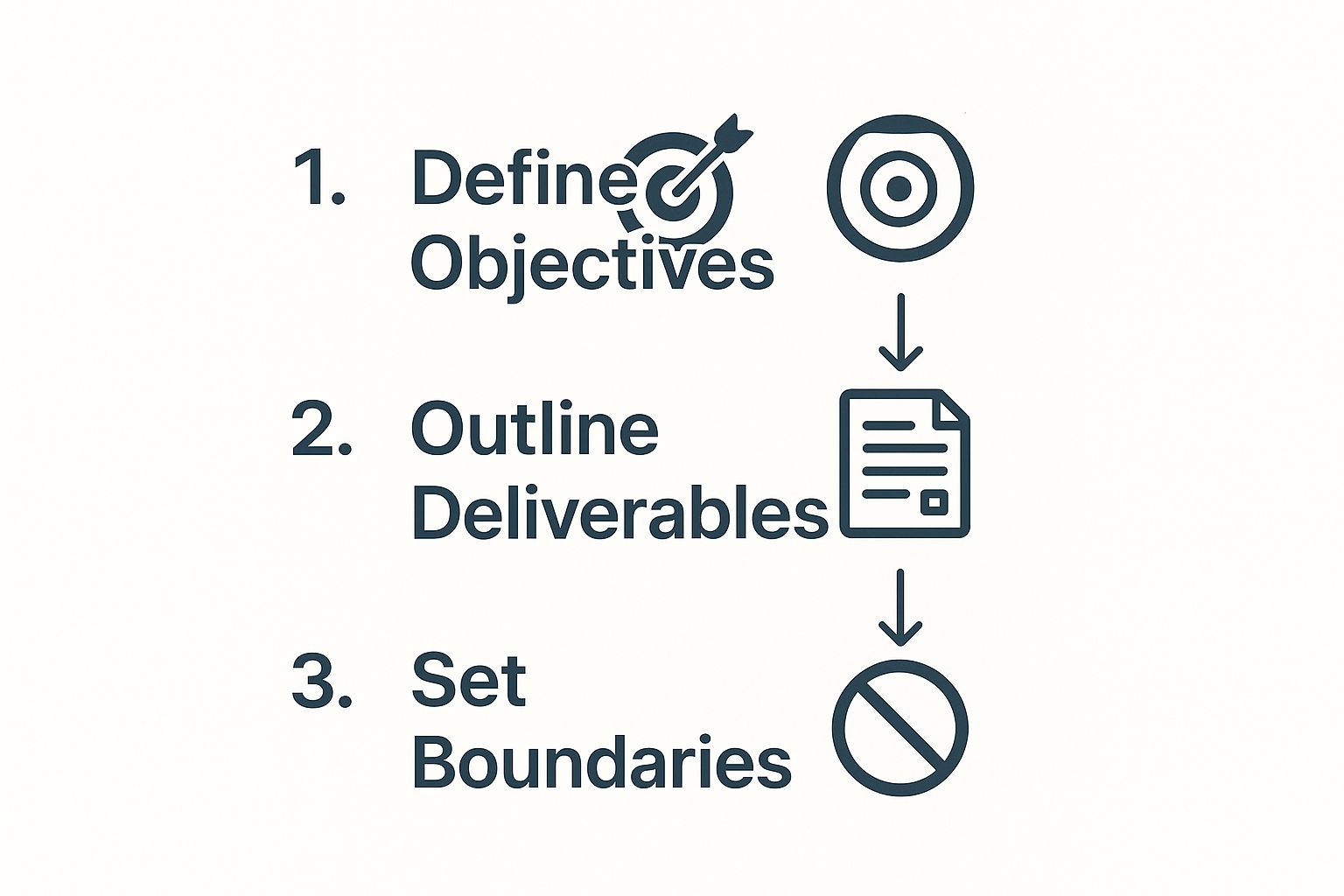
In project management, the term scope gets thrown around a lot. But what does it really mean?
Simply put, scope is the detailed blueprint that defines all the work needed to get a project over the finish line. It clearly maps out the project's objectives, what you'll deliver, the specific tasks involved, the budget, and the deadlines.
Think of it as the project's official boundaries—everything inside is part of the job, and everything outside is not.
Defining the Blueprint for Project Success
Imagine you're building a house. The scope is the architectural blueprint that details every single element before the first brick is laid. It specifies the number of rooms, the exact materials for the floors, the type of windows, and the colour of the paint on the walls.
This blueprint makes sure the client, the architect, and the builders all share the same vision. Without it, the project quickly descends into chaos. You might end up with a five-bedroom house when the client only wanted three, or find yourself way over budget because of last-minute changes to the kitchen layout.
A well-defined scope prevents this mess by creating a shared understanding of the final goal.
The Core Components of Project Scope
Just like a blueprint has different sections, a project scope is built from several key components. Each one answers a critical question about the project's boundaries and goals, leaving no room for guesswork.
These core elements work together to form a complete guide for the entire team:
- Objectives: This is the "why" behind it all. It defines the specific business problem you're solving or the value you aim to create.
- Deliverables: These are the tangible things the project will produce. It could be a new software feature, a marketing campaign, or a finalised research report.
- Exclusions: Just as important as what's included is what's not. This section explicitly lists tasks or features that are out of scope, heading off misunderstandings before they start.
- Constraints: These are the project's limitations. Think budget, timeline, available people, or technology restrictions.
This example from Asana shows how these pieces come together to create a clear project scope.

The screenshot neatly breaks down the scope into manageable parts, from high-level deliverables down to specific out-of-scope items. It becomes the single source of truth for everyone involved.
Aligning Teams and Managing Expectations
Ultimately, defining the scope is all about getting everyone on the same page. It acts as a North Star, guiding decisions and keeping the team focused on the same target. When stakeholders ask for new features or changes, the scope statement becomes the objective reference point for weighing those requests.
In the Netherlands, for example, project scope management is a high priority. Many Dutch organisations use tools like Asana and Jira to meticulously define and track project boundaries. This approach helps reduce common headaches like scope creep by providing clear, real-time reporting on where things stand. You can learn more about project management trends in the Netherlands and see how it’s done.
By setting these boundaries early, you set your project up for success right from the start.
How to Define Project Scope Step by Step
Defining a project's scope isn't a one-off task you tick off a list; it’s a careful process. It’s about turning a big idea into a concrete, actionable plan through thoughtful planning and clear communication.
Following a structured approach ensures you capture everything needed, creating a solid foundation for the project. Each step builds on the last, adding layers of detail and clarity until everyone is on the same page.
Step 1: Start with Clear Objectives
Before you figure out what work needs to be done, you have to know why you’re doing it. The first step is always to nail down crystal-clear project objectives. These are the high-level goals that answer the most important question: "What does success actually look like?"
Think of your objectives as the destination on a map. Are you trying to boost user engagement by 15%? Maybe the goal is to cut system downtime by 20% next quarter. These goals have to be specific, measurable, and tied directly to a real business need. A vague goal like "improve the user interface" won't cut it. A strong objective sounds more like, "Redesign the user dashboard to reduce the average time to complete key tasks by 30%."
Step 2: Define Tangible Deliverables
Once the objectives are set, it’s time to identify the deliverables—the actual, tangible things your team will produce. Deliverables are the "what" of your project. If the objective is your destination, the deliverables are the specific landmarks you'll build or pass on the way.
For an IT project, this could mean things like:
- A functioning user authentication module.
- A complete UI/UX design document.
- A fully tested and deployed mobile app for iOS and Android.
Breaking the final product down into smaller, manageable pieces is essential. It not only makes the project easier to track but also clarifies exactly what stakeholders can expect at each stage. To get a better handle on what's needed for these outputs, our guide on software resource planning can help you align your team's capacity with the project's demands.
Step 3: Gather Stakeholder Requirements
You know what you’re building. Now you need the specifics from the people who will actually use it or be affected by it. This step is all about gathering detailed requirements from your key stakeholders—customers, end-users, department heads, and executives.
This is usually the most interactive part of the scoping process. It demands active listening and asking the right questions, whether in workshops, interviews, or surveys. A huge part of preventing scope creep down the line is mastering the art of writing effective business requirements from the very beginning.
Step 4: Set Firm Boundaries with Exclusions
Defining what's in the project is only half the battle. You also have to be explicitly clear about what's out. This is where you outline the project's exclusions and constraints. Exclusions are the specific features or tasks that you’ve decided not to do, leaving no room for assumptions later.
A project without clear boundaries is a project destined for scope creep. Explicitly listing exclusions manages expectations and provides a firm "no" when out-of-scope requests inevitably arise.
For instance, if you're building a new mobile app, an exclusion might be: "This project will only include the iOS version; the Android version is not in scope for this phase." Constraints are the limitations you have to work within, like the budget, timeline, or available technology.
This visual shows how these steps flow together, moving from a high-level goal to a set of firm project boundaries.

As the infographic shows, it’s a logical progression: start with your objectives, outline what you’ll deliver, and then draw a clear line around the project to create a well-defined scope.
Step 5: Secure Formal Sign-Off
The final move is to pull all of this information together into a formal project scope statement and get it signed off by all key stakeholders. This document becomes the single source of truth for the project—a written agreement that everyone has reviewed and approved.
This isn't just a bit of paperwork. A sign-off represents a shared commitment to stick to the defined scope. It also kicks off the formal change control process, meaning any future changes have to be properly evaluated for their impact on time, cost, and resources before they get the green light. With everyone aligned, the project is officially ready to go.
Crafting Your Project Scope Statement
Once you've mapped out the objectives, deliverables, and boundaries, it's time to put it all together in a formal project scope statement. Don't think of this as just another piece of paperwork. Treat it as a contract for clarity—the single source of truth that gets your team aligned, manages stakeholder expectations, and sets the baseline for every decision that follows.
A well-crafted statement is what stops a project’s goals from becoming a moving target. In fact, research from the Project Management Institute points to poor scope definition as a primary reason projects fail. Without this document, you're flying blind, making it nearly impossible to measure progress or know what success even looks like.
The Anatomy of a Powerful Scope Statement
A truly effective scope statement manages to be both comprehensive and concise. It takes all the critical information you've gathered and organises it into a structure that anyone, from a developer to an executive, can quickly understand. It’s all about creating a shared reality for what the project will deliver, and just as importantly, what it won't.
Here are the essential pieces every solid IT scope statement needs:
- Project Justification: A quick explanation of the business problem or opportunity. Why are we doing this project right now?
- Key Objectives: List the specific, measurable goals. A good example is, "Reduce system latency by 15% within Q3."
- Major Deliverables: Detail the main tangible outputs, like a new software module, a user training manual, or a completed data migration plan.
- Inclusions: Be explicit about what work and features are part of the project.
- Exclusions: This is your first line of defence against scope creep. Clearly list what is definitively not included.
- Constraints: Note down any known limitations. This could be a fixed budget of €50,000, a hard deadline, or a dependency on specific third-party tech.
- Assumptions: Document anything you're taking for granted that could derail the project if it turns out to be wrong.
Building Your Scope Statement: A Practical Template
Let's move from theory to action. Below is a practical, copy-paste template designed for modern IT projects. You can adapt this structure right away to bring order and clarity to your next initiative, ensuring you cover all your bases and leave little room for guesswork.
A strong scope statement is your project's constitution. It provides the rules of engagement and the ultimate reference point when changes are requested, ensuring decisions are deliberate and their impacts are fully understood.
Here’s a template you can use:
Project Scope Statement Template
| Section | Description | Example (New CRM Implementation) |
|---|---|---|
| Project Justification | A brief statement on the business need. | "Our current sales process is inefficient, leading to a 10% loss in potential leads monthly." |
| Project Objectives | 2-3 SMART goals for the project. | "1. Implement a new CRM system by 31 December. 2. Automate lead tracking to improve data accuracy." |
| Key Deliverables | The main outputs of the project. | "1. A fully configured CRM platform. 2. A trained sales team. 3. Migrated customer data." |
| Project Boundaries | Clear inclusions and exclusions. | In Scope: Data migration for sales contacts. Out of Scope: Marketing department integration. |
| Constraints & Assumptions | Known limitations and beliefs. | Constraint: Budget is fixed at €75,000. Assumption: Existing hardware meets system requirements. |
| Acceptance Criteria | How deliverables will be approved. | "The sales director must sign off that the system accurately tracks leads from creation to close." |
This structured approach makes sure the scope in a project isn't just an idea but a documented agreement. It becomes the bedrock for measuring performance, since you can clearly compare the final outcome against the original plan. For more on this, it's worth exploring the key differences between tracking vs measuring project outcomes to really nail down your success metrics.
Ultimately, this statement is your best tool for keeping the project on the rails and delivering real value.
Why Strong Scope Management Is a Game Changer
Trying to manage a project without a clearly defined scope is a bit like setting sail without a rudder. At first, small, uncontrolled turns might not seem like a big deal, but they gradually pull you further and further off course until you’re completely lost. In the world of project management, we call this slow, almost invisible drift scope creep.
Scope creep is the quiet enemy of project success. It sneaks in when stakeholders add new features or requirements after the project is already underway, often without anyone stopping to assess the real impact. A “small tweak” here and a “quick addition” there can quickly snowball, draining your budget, pushing back deadlines, and burning out your team.
This is where strong scope management becomes non-negotiable. It’s not about creating rigid bureaucracy; it’s about disciplined control that protects the project and makes sure it actually delivers on its original promise.
Preventing Budget Overruns and Delays
The most obvious benefit of tight scope control is financial stability. When a project's boundaries are crystal clear and actively defended, it becomes much harder for unplanned work to slip through the cracks and inflate costs. Every single proposed change has to go through a formal process where its impact on the budget and timeline is properly analysed.
This focus on control is critical for reducing budget wastage—which is estimated to be around 10% of every project dollar spent globally. In fast-moving sectors like IT and finance, even minor scope mismanagement can lead to serious financial losses and operational headaches.
Think of the scope statement as a firm contract. It empowers project managers to ensure every euro and every hour is spent on delivering agreed-upon value, not on unvetted extras.
Boosting Team Morale and Focus
Constant changes don't just hit the timeline; they crush team morale. When the finish line keeps moving, people get frustrated and demotivated. They lose that sense of accomplishment when their hard work is constantly being redirected by new, unplanned requests. It’s a fast track to burnout and a drop in quality.
Good scope management acts as a shield for the team. It creates a stable, predictable environment where everyone knows exactly what they need to do. This clarity allows team members to focus on their work, build momentum, and feel a sense of collective progress. Maintaining this focus is crucial, and you can learn more about how to optimise work patterns with data transparency in our article on WhatPulse.
Achieving Predictable Outcomes and ROI
At the end of the day, any project is meant to deliver a specific outcome and generate a return on investment (ROI). Undisciplined scope changes put all of that at risk by blurring the project's original goals. What started as a focused initiative to solve one business problem can morph into an unwieldy beast that tries to do everything and accomplishes nothing well.
Effective scope management keeps the project laser-focused. By sticking to the plan, you dramatically increase the odds of hitting your targets on time and within budget, which translates directly to a predictable and maximised ROI. It’s no surprise that strong scope management is consistently named one of the most fundamental project management best practices. It turns a project from a risky gamble into a reliable strategic investment.
Navigating Common Scope Management Challenges

Even with a perfectly written scope statement, projects rarely go exactly to plan. That’s just the reality of it. The real difference between a project that succeeds and one that goes off the rails is how well your team sees these hurdles coming and handles them when they pop up.
Managing project scope isn’t something you do once and then forget about. It's an active, ongoing effort that demands your attention. You’ll constantly face vague requests from stakeholders, deal with conflicting priorities, and feel the pressure of last-minute changes.
Instead of seeing these challenges as pure roadblocks, it's better to treat them as chances to get everyone back on the same page. The trick is to have your toolkit ready before you’re in the thick of it.
Translating Vague Requirements into Clear Actions
One of the most common issues you'll run into is getting vague requirements from stakeholders. You’ll hear things like, "just make it more user-friendly" or "we need better performance." These sound simple enough, but they can be interpreted in a dozen different ways, which is a fast track to scope creep and disappointment.
Your first job is to be a translator. You need to turn these fuzzy ideas into solid, measurable goals. This is where something like user story mapping is a massive help. It's a group exercise where you break down a big request into the specific actions a user would take. This process forces everyone to define what "user-friendly" actually means in practice.
Another great technique is prototyping. A quick wireframe or a simple interactive mockup can make an abstract concept feel real. Stakeholders can click around and give you concrete feedback, turning a wishy-washy idea into a well-defined feature.
Resolving Stakeholder Disagreements
So, what happens when two of your key stakeholders have completely different visions for the project? It’s a classic problem that can bring progress to a grinding halt. Your job isn't to pick a winner; it's to guide them to a resolution.
Get the disagreeing parties in a room for a focused discussion. The goal here is to steer the conversation away from personal opinions and anchor it back to the project’s main objectives. Ask pointed questions like, "How does this change help us hit our primary goal of reducing system downtime by 20%?"
If you still can’t get them to agree, a prioritisation framework can offer an objective way forward. The MoSCoW method is a go-to for situations like this:
- Must-Have: These are the non-negotiable features. The project fails without them.
- Should-Have: Important, but not absolutely vital. The project can still launch without these.
- Could-Have: These are the "nice-to-have" additions that you’ll include if there's enough time and resources.
- Won't-Have: Features that are explicitly out of scope for this round.
By categorising competing requests with a shared framework like MoSCoW, you change the debate from "who is right?" to "what is most critical for success?" It makes the whole decision-making process more logical and a lot less personal.
Establishing a Respected Change Control Process
The last, and arguably most persistent, challenge is handling those inevitable last-minute change requests. Without a formal system, these requests will blow up your timeline and your budget. The answer is a clear and respected change control process.
This isn't about just saying "no" to every new idea. It’s about making sure every single request is properly looked at. You need to assess its impact on the schedule, cost, and team resources before a decision is made. A simple change request form that captures the what, why, and impact is your best friend here.
Common Scope Challenges and Practical Solutions
The table below breaks down these common challenges and gives you some actionable solutions to keep your project scope from getting out of control.
| Challenge | Impact on Project | Recommended Solution |
|---|---|---|
| Ambiguous Requirements | Causes rework, delays, and frustrated stakeholders. | Use user story mapping and prototyping to create tangible examples and get specific feedback. |
| Stakeholder Conflicts | Leads to decision paralysis and shifting priorities. | Facilitate discussions centred on project objectives and use frameworks like MoSCoW to prioritise logically. |
| Last-Minute Changes | Results in scope creep, budget overruns, and team burnout. | Implement a formal change control process where every request is documented and its impact is fully assessed. |
By getting a handle on these techniques, you shift scope management from a reactive, defensive game to a proactive strategy. It empowers your team to navigate the messy reality of projects and actually deliver on what you promised.
Answering Your Questions About Project Scope
Even with a solid plan, the real world of project management is full of tricky situations and "what if" scenarios. Getting the scope right is often where things either go smoothly or start to fall apart.
Let's tackle some of the most common questions that pop up when teams start putting these ideas into practice. Think of this as a quick field guide to help you navigate those conversations.
What's the Difference Between Project Scope and Product Scope?
It’s incredibly common to mix these two up, but they cover very different ground. The easiest way to think about it is to imagine you're building a house.
- Product scope is the blueprint for the house itself. It defines what the final thing will be—how many bedrooms, the size of the kitchen, the type of windows. It’s all about the features and functions of the end result.
- Project scope is everything you have to do to build that house. It's the work of laying the foundation, framing the walls, hiring electricians, and getting the inspections. It's the "how" that brings the "what" to life.
You can't have one without the other. The project scope is the roadmap you follow to deliver the product scope.
How Should I Handle a Scope Change from a Key Stakeholder?
This is a classic project manager's dilemma. When a powerful stakeholder asks for a change, your first instinct might be to just say "yes" to keep them happy. Resist that urge. The best response isn't a quick "yes" or "no," but a calm, "Let's run that through our process."
Your first step is to guide the request into your formal change control process. Document exactly what they're asking for. Then, do your homework: analyse the real impact on the budget, the timeline, and your team's workload. Are there new risks?
A formal change control process takes the emotion out of the conversation. It turns a subjective request into an objective business decision, protecting the project while still respecting the stakeholder.
Once you have that analysis, you can present the full picture to the decision-makers. This way, any choice to approve or deny the change is based on solid data, not just on who asked the loudest.
Can Project Scope Change in an Agile Project?
Yes, it's not only possible—it's expected. Agile was designed from the ground up to welcome change, but it does so in a very structured way. It’s a world away from the chaos of scope creep in a traditional project.
While the big-picture vision for the product usually stays put, the detailed scope is meant to be flexible. The key is how those changes are managed. A new idea or request doesn't just get thrown into the middle of the current sprint; that would completely derail the team.
Instead, new items are added to the product backlog. There, they get prioritised against everything else that's waiting to be done. This system allows the project to adapt and evolve as you learn more, ensuring the team is always focused on delivering what’s most valuable right now, without causing constant disruption.
Ready to gain clear insights into how your teams spend their time on projects? WhatPulse provides privacy-first analytics to help you understand application usage, identify bottlenecks, and optimise resource allocation without compromising employee trust. See how work really happens and make data-driven decisions to improve your project outcomes. Learn more at WhatPulse.
Start a free trial